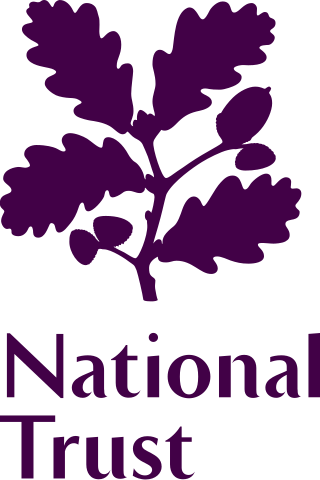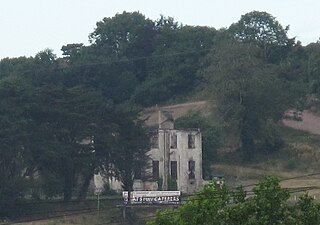Related Research Articles

The National Trust is a charity and membership organisation for heritage conservation in England, Wales and Northern Ireland. In Scotland, there is the separate and independent National Trust for Scotland.

The Irish Georgian Society is an architectural heritage and preservation organisation which promotes and aims to encourage an interest in the conservation of distinguished examples of architecture and the allied arts of all periods across Ireland, and records and publishes relevant material. The aims of this membership organisation are pursued by documenting, education, fundraising, grant issuance, planning process participation, lobbying, and member activities; in its first decades, it also conducted considerable hands-on restoration activities.

Fota Wildlife Park is a 100-acre (40 ha) wildlife park located on Fota Island, near Carrigtwohill, County Cork, Ireland. Opened in 1983, it is an independently funded, not-for-profit charity that is one of the leading tourism, wildlife and conservation attractions in Ireland. The park had an attendance of 455,559 visitors in 2017, making it the eleventh most popular paid attraction in Ireland for that year.
Fota is an island in Cork Harbour, Ireland, just north of the larger island of Great Island. Fota Island is host to Ireland's only wildlife park – as well as the historical Fota House and gardens and golf course owned by the "Fota Island Golf Club and Resort". The island comprises two townlands both called Foaty: one each in the civil parishes of Clonmel and Carrigtohill.

Kanturk is a town in the north west of County Cork, Ireland. It is situated at the confluence of the Allua (Allow) and Dallow (Dalua) rivers, which stream further on as tributaries to the River Blackwater. It is about 50 kilometres from Cork and Limerick, and lies just north of the main N72 road, 15 km from Mallow and about 40 km from Killarney. Kanturk is within the Cork North-West Dáil constituency.
An Taisce – The National Trust for Ireland, established on a provisional basis in September 1946, and incorporated as a company based on an “association not for profit” in June 1948, is a charitable non-governmental organisation (NGO) active in the areas of the environment and built heritage in the Republic of Ireland. It considers itself the oldest environmental and non-governmental organisation in the country, and is somewhat similar to the National Trust of England, Wales and Northern Ireland but based more directly on the National Trust for Scotland. Its first president was the prominent naturalist Robert Lloyd Praeger.

Tourism in the Republic of Ireland is one of the biggest contributors to the economy of Ireland, with 9.0 million people visiting the country in 2017, about 1.8 times Ireland's population. Each year about €5.2bn in revenue is made from economic activities directly related to tourists, accounting for nearly 2% of GNP and employing over 200,000 people. In 2011 alone, Ireland was voted 'Favourite holiday destination in the World' by readers of Frommer's Guide, Lonely Planet listed Ireland as the world's friendliest country and Cork City as one of the top ten cities in the world and the Irish tourist boards website, DiscoverIreland.com, was named the best tourist board website in the world. Most tourists visiting Ireland come from the United Kingdom, the United States, Germany and France.

Strokestown Park House is a Palladian style Georgian house in Strokestown, County Roscommon, Ireland, set on about 300 acres (120 ha).

Aldborough House is a large Georgian house in Dublin, Ireland. Built as a private residence by 1795, the original structure included a chapel and a theatre wing.

Vernon Mount is a ruined Georgian manor house in Cork, Ireland. It was built between the 1780s and early 1790s to designs attributed to Abraham Hargrave. Originally built for the merchant Hayes family, the house was named for Mount Vernon, the home of US president George Washington. Passing through several owners, the house remained largely disused and subject to deterioration from the late 20th century. It was included in the Record of Monuments and Places by the National Monuments Service, and on the Record of Protected Structures for Cork County Council. It remained largely intact until 2016, when a significant fire largely gutted the house, and the building was subsequently listed on the derelict sites register. In 2021, the building was subject to a funding request for stabilisation works due to "risk of collapse".

The Irish Landmark Trust is an architectural conservation and educational organisation founded in Ireland in 1992. Similar to the British Landmark Trust, it is a registered charity which renovates buildings of historic interest and makes them available for holiday rental, while collating and sharing information on construction and restoration techniques. As of 2018, the organisation had restored over 30 properties on the island of Ireland, including a number of lighthouses and castles.

The Dublin Civic Trust is an architectural conservation and educational organisation founded in 1991 that works to identify, record, preserve and publicise Dublin's architectural heritage. The trust also comments and assists to a lesser extent with other buildings outside of Dublin.

Tailors' Hall is the oldest of two surviving guildhalls in Dublin, Ireland. It is located on Back Lane, off High Street, in the part of the city known as the Liberties. Aside from meetings of its own and many other of the guilds of Dublin, the hall has hosted many social, cultural and educational events. It has been used as a court-house, a barracks, a school, a place of worship and in place of Dublin's City Hall. It was also a meeting place of the United Irishmen, and the site of the Back Lane Parliament. The Tailors' Guild having fully released it by 1873, the building hosted a Christian Mission and later the Legion of Mary. The building having become uninhabitable by the mid-20th century, the Irish Georgian Society launched a restoration campaign in 1966, and it was reopened in 1971. It now holds the headquarters of Ireland's national heritage charity, An Taisce, and can be visited, and rented for events.

The Honourable Dorothy Elizabeth Bell was an Anglo-Irish aristocrat, landowner, Red Cross nurse and a farmer. Bell also served with a number of charitable organisations in Ireland, including the Irish Red Cross Society, Victoria Hospital and the Irish Girl Guides.

The Custom House is an early 19th-century building in Cork, Ireland. Originally developed as a custom house and opened in 1818, the Cork Harbour Commissioners took over the building in 1904. The Port of Cork Company vacated the building in early 2021. The Custom House is, together with a number of other buildings on the same site, listed by Cork City Council on its Record of Protected Structures.
The Limerick Civic Trust is an environmental, architectural conservation and educational organisation founded in 1982 that works to identify, record, preserve and publicise Limerick's culture, history, environment and architectural heritage. Although the trust works in conjunction with local authorities, state agencies and various commercial and professional entities, it remains an independent organisation and is entirely self-funded.
Ian Lumley is an Irish conservationist, who has notably served with An Taisce - The National Trust for Ireland over an extended period, principally as its heritage officer, and latterly as one of its three senior managers, as head of advocacy.
References
- ↑ "Our Story". Irish Heritage Trust. Retrieved 12 June 2023.
- ↑ "Irish Heritage Trust". www.gov.ie. Retrieved 13 June 2023.
- 1 2 McDonald, Frank (3 July 2006). "New heritage trust to protect at-risk properties". The Irish Times .
A heritage trust with the power to acquire at-risk properties it feels have significant heritage value has been set up by Minister for the Environment Dick Roche.
- ↑ "The Irish Heritage Trust CLG - FINANCIAL STATEMENTS (2021)". www.vision-net.ie. Retrieved 12 June 2023.
- ↑ Kelleher, Olivia (5 December 2007). "Fota House to be managed by Irish Heritage Trust". The Irish Times . p. 2.
- ↑ Leland, Mary (27 September 2011). "Art of protecting our built and natural heritage". Irish Examiner. Retrieved 5 May 2024.
- ↑ "Minister Launches Irish Heritage Trust's 10-Year Strategy". Hospitality Ireland. 19 May 2023. Retrieved 12 June 2023.
- ↑ "ESB and Irish Heritage Trust unveil plans for museum of Georgian-era Dublin". The Irish Times. Retrieved 7 July 2023.
- ↑ deLongchamps, Kya (3 June 2023). "Five great houses and gardens of Ireland to visit this summer". Irish Examiner. Retrieved 12 June 2023.
- ↑ Kane, Conor (4 April 2023). "Rare section of Johnstown Castle opens to public" . Retrieved 12 June 2023.
- ↑ "Behind the News: Kevin Baird, heritage trustee". The Irish Times. Retrieved 12 June 2023.
- ↑ (Editorial) (4 July 2006). "Valuing our heritage". The Irish Times . p. 15. Retrieved 5 May 2024.